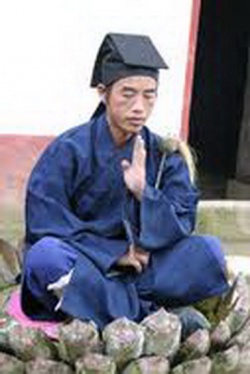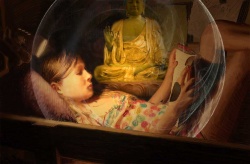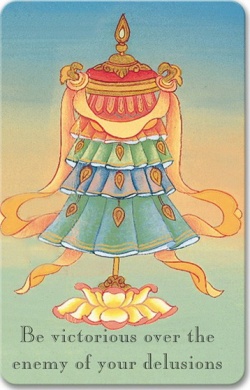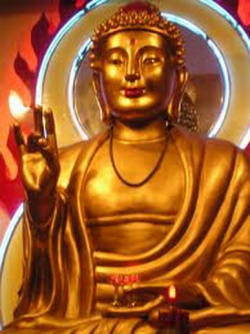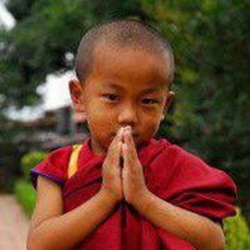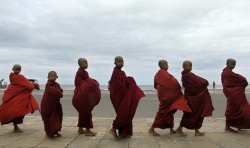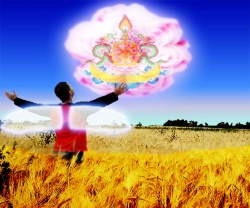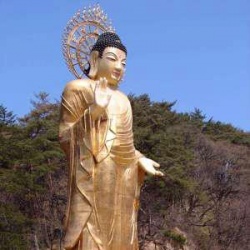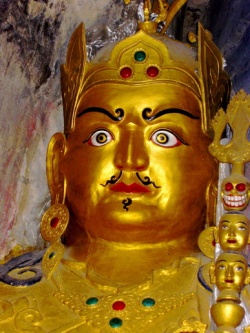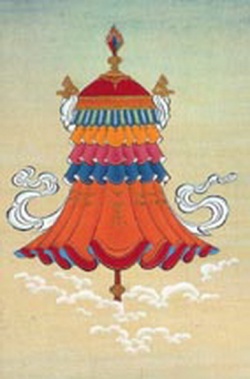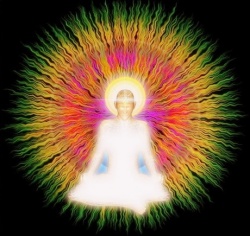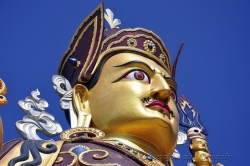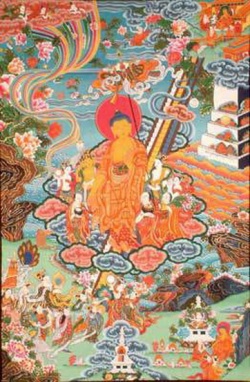The Relationship between Sutrayana and Vajrayana
Question(19): The practice of Tibetan Vajrayana is grounded on the basis of Sutrayana.
What I would like to know is: What is the relationship between the studying and the practice of Sutrayana Buddhism, and that of Vajrayana Buddhism?
What is the difference between Vajrayana and Sutrayana?
Answer: It is true that Tibetan Vajrayana studying and practice is grounded on the basis of Sutrayana, however, the saying that “Vajrayana is grounded on the basis of Sutrayana” does not necessarily mean that people need to finish all the Sutrayana studies before they can go into the tantric study.
Here, what is intended by “basis” contains several aspects of meanings:
Firstly, from a historical viewpoint, the initial rising of Tibetan Buddhism began from the propagation of the Sutrayana scriptures.
According to the Canonical Book of the Tang Dynasty, around the historical period of East Jin, the Tibetan region went under the reign of King Lha-Thothori Nyentsen (in the Canonical Book of the Tang Dynasty, his name was Tuotudu).
In the year 317 A.C., when the King was in his sixties, one day, four treasured texts fell, suddenly, from the sky, and they were:
The Ornament of Jewel Chest Sutra (Karandavyuha Sutra), The Sutra of a Hundred Invocations and Prostrations,
The Sutra of Ten Virtues, and The Sutra of Twelve Links of Dependent Origination (Twelve Nidanas); and along with this, there was a voice echoing in the sky, declaring that:
“From today onward, when five generations have passed, the meaning of these will be understood.” – which means that it would not be until five dynasties later that people could understand the meaning of these sutras.
So, during the reign of Dharma King Songtsen Gampo, the Tibetan region began to have its written language, and people really began to know the meaning of these sutras.
And it was from then on that the Sutrayana scriptures laid the first founding stone, sturdily, for the future propagation of Vajrayana Buddhism.
Secondly, tantric practice and accomplishment must require the Sutrayana renunciation and bodhicitta mind, as their basis. Generally speaking,
the ritual text of every practice in Tibetan Buddhism, contains, at the beginning, such contents as:
taking refuge, generating the bodhicitta, etc., and in this sense, tantric practice is said to be grounded on the basis of Sutrayana.
With respect to the relationship between the two, the Buddha mentioned in the Aryamanjusri Satyanama Sutra that:
Sutrayana Buddhism is the causal practice, whereas Vajrayana Buddhism is the resultant practice, and all the teachings and tenets of the Sutrayana school can eventually be subsumed under tantric practice.
It is stated in this sutra that: “The power of expedient means, by various Vehicles, is categorized for the benefit of sentient beings;
All the three Vehicles, eventually, would be concluded in the unique, ultimate, resultant Vehicle.”
Here, the World-Honored One has articulated, himself, that Śrāvakayāna, PratyekaBuddhayāna, and Bodhisattvayāna of Sutrayana, could all, eventually, be subsumed in the Vajrayana school.
And from the temporary point of view, sentient beings have different capacities and propensities, and for this reason, Buddha Shakyamuni has given symptom-based prescriptions, and elucidated countless dharma practices in order to help myriad sentient beings.
However, no matter whether it is Sutrayana Buddhism or Vajrayana Buddhism, its ultimate goal is, without exception, the attaining of Buddhahood.
Driven by this same pursuit, practitioners, who have chosen the Vajrayana tradition, which is very rich in its expedient means of practice, are just like people taking an airplane to the destination; and practitioners,
who have chosen the other traditions, are just like people taking a train or a bus as their vehicle of transport, and from the external appearance, are slower than tantric practitioners to reach the destination. The target is definitely the same, it is just that the means and the tools are different.
Many spiritual masters and virtuous people in Tibetan Buddhism, such as Je Tsongkhapa and Mipham Rinpoche,
have expressed this idea, respectively, in their treatises named: Great Exposition of the Secret Mantra(Ngak Rim Chenmo), and Instruction on the Middle Way
– If a comparison is made with the Sutrayana school, the Vajrayana school, in its temporal manifestations, has such featured characteristics as: it has more expedient means,
it does not require practitioners to go through long eons of practice, with hardship, throughout countless lives, and it is prescribed for sentient beings who are endowed with the sharpest aptitudes and capacities.
Yet, in the final achievement, it is no different to that of the Sutrayana school. This is a little bit like the distinction between the Madhyamaka Svātantrika approach and the Madhyamaka Prāsangika approach:
from the temporary level, the two could have many differences between them; however, from the level of absolute reality, they are completely the same in their ultimate intentions.
And similarly, the Sutrayana school may also be divided into two subsidiaries
– the rapid tradition and the gradual tradition, depending on whether the rapid approach or the gradual approach is taken to attain enlightenment
– although the length of time of their practice, as well as their cause-and-condition, and their approaches to enlightenment, are different, their final results do not show the slightest difference.
Although some people in the Tibetan region, such as Yongdun Pandita, believe that the Buddhahood attained in Sutrayana Buddhism, and that in Vajrayana Buddhism, are a little bit different
– and their assertions are supported with relevant scriptural evidence – what is mentioned here is only the more unanimously acknowledged viewpoint in Tibetan Buddhism, where personal opinions, such as that of Yongdun Pandita, are not involved.
Both Omniscient Drimé Özer (Venerable Longchenpa) in his book entitled: Finding Comfort and Ease in the Nature of Mind on the Great Perfection
– the Great Vehicle Commentary, and Venerable Jigme Lingpa in his:
Treasure of Precious Qualities, have indirectly mentioned the differences between Sutrayana and Vajrayana Buddhism, such as: the differences in their temporary means of practice; the differences in their pith instructions in discerning views;
the differences in their way of counteracting and eliminating afflictions; the differences in their speed to attain enlightenment.
Those who are interested in this topic, and who have read such books as
– Dudjom Rinpoche’s The Nyingma School of Tibetan Buddhism: its Fundamentals and History, Khenpo Nyoshul Khen Rinpoche’s The History of the Dzogchen Tradition of the Nyingma, Omniscient Drimé Özer (Venerable Longchenpa)’s The Commentary on Heart Essence,
and History of Buddhism by Guta – would know that although the final achievements of Sutrayana Buddhism and Vajrayana Buddhism are completely the same, tantric practitioners, by using the expedient practices in Vajrayana school, attain Buddhahood in an extremely fast way.
And also, if you are familiar with such books as: Memoirs of Eminent Monks, and A Compendium of the Five Lamps:
Five Historical Texts on Zen Tradition, you will not feel confused about the expedient ways in Vajrayana practice,
because in these texts, there were also exemplary accounts about how a number of great spiritual masters and virtuous people, in the Han region, quickly attained accomplishment with their own expedient means of practice.
It is merely from a general perspective of normal circumstances, that we say: that the expedient ways of practice in Vajrayana tradition are far more obvious, and more numerous than those of the Sutrayana tradition.
Lama Norlha Rinpoche, who has, on his visits to the Han region from Tibet, made great contributions to the propagation of tantric Buddha-dharma, once delivered a paragraph like this:
“There is no difference between Vajrayana Buddhism and the Pure Land Buddhism in the Han region; in the practising of any yidam deity, a devout practicing of the Pure Land (Sukhavati) practice in the end, is a must.”
And his words were completely true, because both Dzogchen and Mahamudra have ritual texts and practices about taking rebirth in the Pure Land (Sukhavati).
Lama Kangkar Rinpoche also mentioned that taking rebirth in the Pure Land (Sukhavati) (in Pure Land school) is the enlightenment within a single lifetime in Vajrayana school, and is, truly, not inter-contradictory with attaining Buddhahood within a single lifetime.
In the Han region, Master Hong-yi, Master Yuan-ying, and Yuan-yin the Old Man, also advocate a combined practice of Chan (Zen) and Pure Land,
or of Pure Land and Tantrayana as an integrated whole. Venerable Master Hsuan Hua, too, has stated that:
“Although the Buddhist traditions of Chan (Zen), Scripture, Vinaya, Vajrayana, and Pure Land are five traditions, in the final analysis, what they teach are but one, not two.”
Similarly, Master Yong-jia has said that: “Chan (Zen) leads to enlightenment, scriptural teachings also lead to enlightenment.” That’s why we have repeatedly emphasized that if people thoroughly understand the predominate tenets of Buddha-dharma,
they will naturally gain an impartial and harmonious understanding of all the Buddhist schools and traditions; if people are trapped by their attachment to their own school and traditions,
the harmonious and integral whole of Buddha-dharma of Buddha Shakyamuni will be torn apart artificially.
Not only are Sutrayana and Vajrayana not two divergent roads in their ultimate sense, but also all the Vajrayana practices themselves,
which could generally be divided into eight major lineages, are an integrated whole, or of perfect oneness in their real nature.
When Buddha passed into nirvana, all the great spiritual teachers(spiritual friends, Kalyāṇa-mitta), who truly teach or propagate Buddha-dharma, were actually the nirmanakaya or emanation of Buddha,
and all that they teach or propagate are the Buddha-dharma of Buddha Shakyamuni.
As is recounted in the Nirvana Sutra, Buddha said to Ananda:
“Ananda, don’t be sorrowful; Ananda, don’t cry; in future times, I will manifest as spiritual friends(Kalyāṇa-mitta), benefiting all of you.”
So, Lobsang Chökyi Gyaltsen, the 4th Panchen Lama, said that: “The Mahasiddha Padmasambhava of great wisdom will manifest himself as the Glorious Dīpaṃkara (Atiśa), then again as Lobsang Drakpa (Je Tsongkhapa) – I have no other object of refuge.”
Great Master Gendun Gyatso, the 2nd Dalai Lama, also said: “Siddha Rigdzin Padmasambhava; Atisha, the head ornament of the five hundred ones; Buddha Vajradhara Tsongkhapa – the dance of various manifestations, to you, I prostrate.”
Therefore, all the major lineages in Tibetan region universally agree that: Guru Rinpoche of the Nyingma school, Je Tsongkhapa of the Gelug school, Master Atiśa of the Kadampa school, Dakpo Lharje of the Kagyü school, and Sakya Pandita Kunga Gyaltsen of the Sakya school – were the same nirmanakaya.
And Patrul Rinpoche, too, has said that: “Sakya Pandita, who fully understood and elucidated the five sciences; Je Tsongkhapa, the origin of excellent teachings of both Sutrayana and Vajrayana;
Venerable Longchenpa (Omniscient Jetsun Drimé Özer), the lord of all the Buddha-dharma – the three great ([[emanations] of) Manjushri]] of the Land of Snows, to you, I prostrate.”
It is very clearly revealed, here, that Sakya Pandita, Master Je Tsongkhapa, and Jetsun Drimé Özer, are three emanations of Bodhisattva Manjushri, and indeed, this statement is unanimously acknowledged by all the great masters in the Tibetan Buddhist community.
What coincides with this is the fact that, many lineage masters and virtuous people in Sutrayana traditions are also “multi-taskers”: they were both the lineage master of their own tradition, and a teacher or propagator of the teachings of other traditions.
For instance, prominent master Yongming Yanshou, who was the 6th lineage master of the Pure Land school,
was also, at the same time, a great lineage master of Fa-yan sub-school of the Chan school; his concept, of Chan and Pure Land being a harmonious whole, could be seen in the book titled:
Record of the Mirror of Orthodoxy.
Moreover, Chan master Guifeng Zongmi, (who was also the 5th lineage master of Hua-yan or Avatamsaka School),
advocated the harmonious and combined practice of Chan and Scriptures; and there were too many exemplary masters to be listed here, who highly stressed the fact that all schools or traditions are harmonious and harmless among themselves, no matter whether they focus on scriptural teachings or on lineage practices.
Since the Buddha, as well as the great teachers and masters in the past, clearly articulated that all the schools of Buddha-dharma, all the spiritual teachers, are manifestations of the accurate teachings of Buddha,
or of the Buddha himself, junior successors like us really have no reason to act on impulse, or each does their own things in their own way, or slanders each other.
In manifestations, different schools and traditions might possess quite a few differences, but all the differences are not absolute nor permanent,
nor are they incompatible with each other like water and fire. On the contrary, if all the schools and traditions could be viewed as an organic whole, the existence of differences would,
nevertheless, be good proof of the characteristic of Buddha-dharma teaching students in accordance with their aptitudes, and at the same time, each of us could, from the vast ocean of Buddha-dharma, take what we need, and drink the delicious nectar to our heart’s content.
If judged by the discriminating mind, recklessly, Buddha-dharma would definitely suffer from fragmentation; if there were the integral harmony, every practitioner would harvest benefits.
O The nectar of Dharma – the wisdom of all Buddhas,
The supreme jewel, hard to convey and explain in words -
From you, all fortunate ones with faith reap benefits,
Yet, those who have no belief would not even give a glance.
This life, to have joy, it may seem, is but suffering in its real sense,
And passing like a flash of lightening, it is extremely short and swift,
Only those, who focus on mind-training would gain the real benefits,
Disputes of sectarianism are devoid of true meaning.
I have neither awakened the primordial wisdom,
Nor am erudite through extensive learning and reflection,
Words I have spoken, therefore, might have been improper and fallacious,
Which I confess to you, here, and beg your pardon.
May I, in all my future lives, truly understand,
The profound meaning of Buddha-dharma,
May my mind always accord with Dharma,
May I not hurt any sentient being, even in my dreams.
Of whatever schools and traditions the Buddha speaks,
May I study and practice, with pure visions,
All the great masters, may you stay, forever,
And the Sangha, may you enjoy peace and increasing auspices.
This book: Questions and Answers on Tibetan Vajrayana, was a collection, in which the eminent monk in the Han region – Master Ji-qun – manifested as a question-raiser, to whom I replied, with reference to scriptural evidence, as well as my own understandings. May this merit be dedicated to the rising of the right discernment, in people’s continuum of mind, that all the Buddhist schools are un-contradictory to each other.
By Tibetan monk: Sodargye Composed in Five Sciences Buddhist Institute (Larung)
